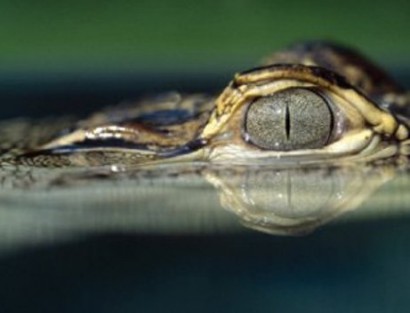Diving, rolling and floating, alligator style
 Try to wrestle an alligator underwater, and you'll probably lose. It's not just that the average gator—at 11 feet long and close to 1,000 pounds—is a whole lot bigger than you are. It turns out alligators have a secret weapon when it comes to moving up, down, and around in the water. Nobody recognized it until now, but alligators actually move their lungs to help them dive, surface, and roll. A team of scientists at the University of Utah in Salt Lake City recently discovered that alligators use their breathing muscles for a second job: to shift their lungs around inside of their body. This helps the animals move up and down in water by allowing them to control their buoyancy, or which parts of them float and which parts sink. To dive, they squeeze their lungs toward their tail. This tips a gator's head down and prepares it to plunge. To surface, the alligators move their lungs towards their head. And to roll? They use muscles to push their lungs sideways. "The big picture is that lungs are probably more than just breathing machines," says T.J. Uriona. He's a graduate student and one of the scientists from Utah who discovered how alligators use muscles to move their lungs. Alligators have some breathing muscles that people don't have. A large muscle connects the alligator's liver to the bones at its hips. When this muscle pulls the liver down and towards the tail, the lungs get stretched down too. Then, more air flows into the lungs. And when the muscle relaxes, the liver slides up and the lungs get squeezed, pushing air out. What's puzzling is that when this liver-to-hips muscle doesn't work, alligators can still breathe well. That led Uriona and his colleague C.G. Farmer to first study how alligators might use this and other muscle groups surrounding their lungs. To test these muscle groups, the researchers placed electrodes in the muscles of a group of young alligators. Electrodes are tools scientists can use to measure the electrical signals that muscles make when they working. The electrodes showed that alligators clench four groups of muscles when they dive. These include the muscles that pull the lungs back and toward the animal's tail when they tighten. That finding was what made Uriona wonder whether pulling the lungs back helps the alligator dive into the water. To find out, he and Farmer taped lead weights to the animals' tails. This made it harder for the animals to dive nose first. The electrodes showed that with weight added to their tails, the muscles needed to work even harder to pull the lungs far back toward the tail. What would happen if the weights were instead taped to the animals' noses? Adding weight to the front of the body should make a downward dive easier than adding weight to the back of the body. And that's just what the electrodes showed. The muscle groups didn't have to work as hard. And for a rolling alligator? Data from the electrodes showed the breathing muscles on only one side of the body tightened. The muscles on the other side remained relaxed. This squeezed the lungs to one side of the body, making that side rise up in the water. Unlike aquatic animals like fish and seals, alligators don't have fins or flippers to help them move smoothly in the water. But somehow, they still manage to sneak up silently on prey while moving through the water. Uriona says using the lungs for motion might have evolved as a way for gators to surprise unsuspecting prey. "It allows them to navigate a watery environment without creating a lot of disturbance," he says. "This is probably really important when they are trying to sneak up on an animal but they don't want to create ripples." |


















